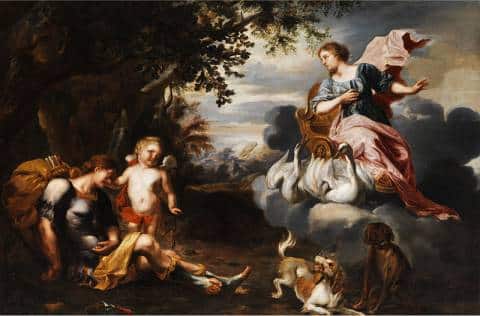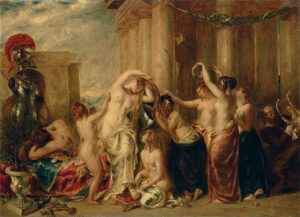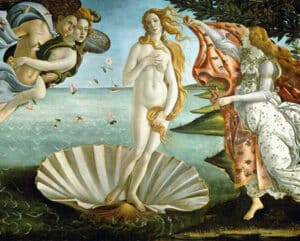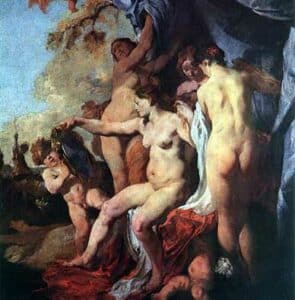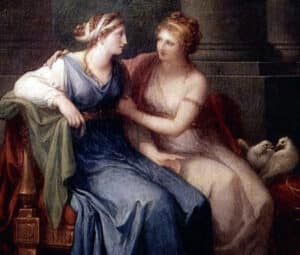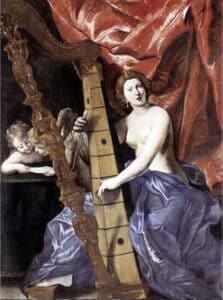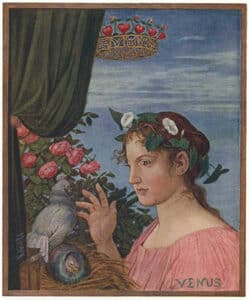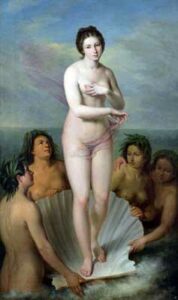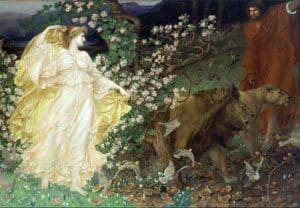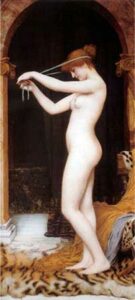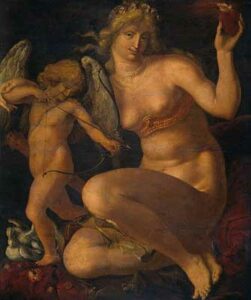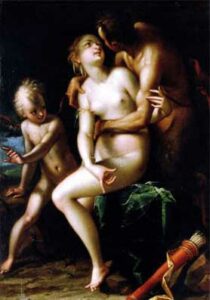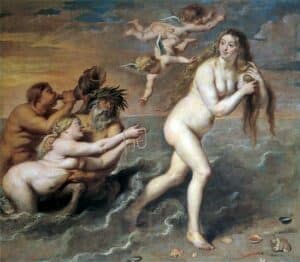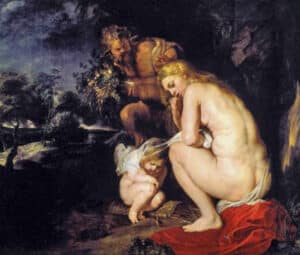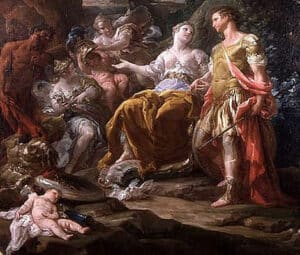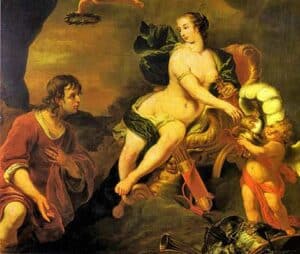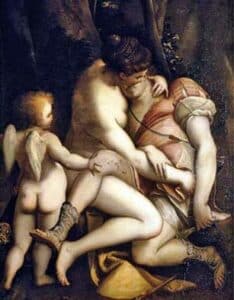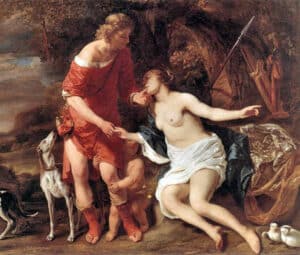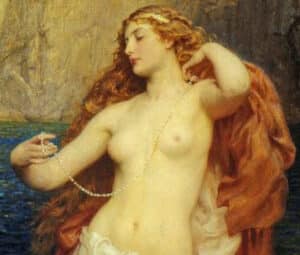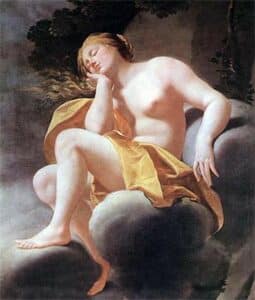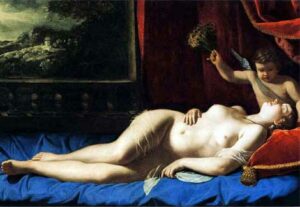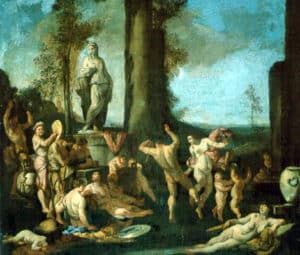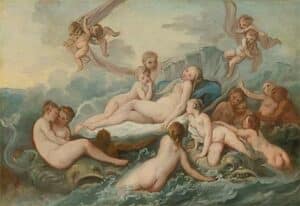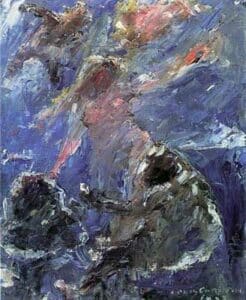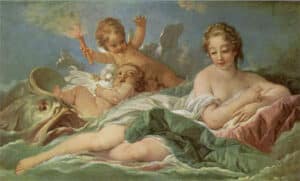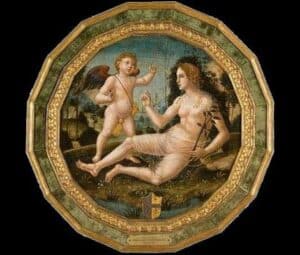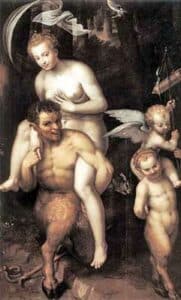One of the greatest and most praised Goddesses of the Greek Pantheon, Aphrodite is the Olympian Goddess of Love and Beauty and the Symbol of Eternal Youth.Linked primarily to erotic love, sexuality, and procreation, she also embodied pleasure, beauty, and youth. Her prominent symbols are her magical girdle, the rose, a mirror, apples and myrtles, a shell, and the flower Narcissus, The Handsome Boy In Love With Himself.
Key Facts
Family tree
| Parents | Zeus and Dione (Homer), Uranus (Hesiod) |
| Partner(s) | Hephaestus, Ares, Dionysos, Hermes, Poseidon, Nerites, Adonis, Anchises, Butes, Phaon, Phaethon |
| Siblings | As Uranus’ Daughter: Cyclopes, One-Eyed Giant Monsters, Erinyes, Giants, Hecatoncheires, The Hundred-Handed Giants, Meliae, Titans As Zeus’ Daughter: Apollo, Ares, Artemis, Athena, Dionysus, Hermes, Aeacus, Angelos, Eileithyia, Enyo, the goddess of war, Eris, Ersa, Hebe, Helen, The Most Beautiful Woman In The World, Hephaestus, Heracles, The Strongest Hero, Minos, Pandia, Persephone, The Enigmatic Queen of the Underworld, Perseus, The Legendary Slayer of Medusa, Rhadamanthus, the Charites, the Horae, the Litae, the Muses, The Divine Inspirations Behind Art, Science, and Culture, the Moirai, Spinners of The Thread of Life, Tyche |
| Offspring | Immortal: Eros, the Greek God of love, Anteros, Beroe, Deimos, Harmonia, Hermaphroditos, Himeros, Iacchus, Peitho, the goddess of persuasion, Phobos, Pothos, Priapos, Rhodos/e Mortal: Aeneas, Astynoos, Eryx, Herophilos/e, Lyros |
Names & Others
| Roman Name | Venus |
| Other Names | Cytherea, Cypria |
| Ancient Greek | Ἀφροδίτη |
| The God of | Love, Beauty, Youth, Sexuality and Procreation, Pleasure |
| Symbols | Magical Girdle, Rose, Myrtle, Apple, Pomegranate, Seashell, Mirror, Pearl, Narcissus |
Name and Etymology
The name Aphrodite is most likely derived from the Greek word aphros (ἀφρός), which signified the foam of the sea. The most common folk etymology says that the second part of her name may derive from the verb δύω (emerge), thus denoting the name “the one who emerged from the foam”, connecting her to Hesiod’s version of her birth by Uranus. It has also been discussed that the second part may mean wanderer or bright.
However, these versions are considered to be wrong. The name derives from an Indo-European root, probably of Semitic origin, but the derivation can only be speculated. With no other probable speculation provided by scholars and researchers, Hesiod’s etymology from the foam is considered to be genuine.
Some common epithets of Aphrodite were Cytheres and Cypria, linking her to the major places of her worship, the islands of Cythera and Cyprus. She was also called Area, from her relationship with Ares, the God of War, and Nikephoros, meaning the bringer of victories. Another common epithet was Pandemos, which denoted her affiliation with sexuality and desire, and Ourania, meaning heavenly, associated with Platonic love.
The Egyptians affiliated her with Hathor, the Romans with Venus, and there is a link with the Norse Goddess Freyja, one of the Vanir, presiding over the same realms as Aphrodite.
Aphrodite’s Origins and Family
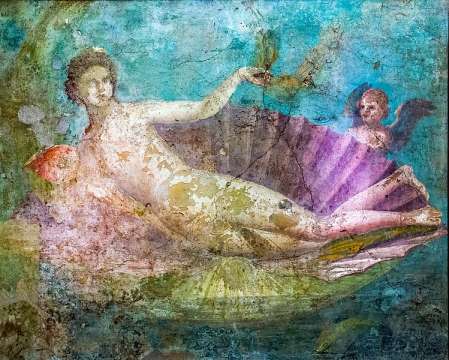
As evidenced by her widespread worship on the Greek islands of Cyprus and Paphos, Aphrodite is most likely connected to the Phoenician goddess Astarte. Astarte was also linked to the Mesopotamian goddess Ishtar and the Sumerian goddess Inanna. From the eighth century, Greece and the Near East actively interacted culturally. Moreover, Herodotus asserts that Syria’s Ascalon housed the most significant site for the cult of Aphrodite.
There are two myths surrounding Aphrodite’s birth. The first one – Homer’s story – says that Aphrodite was the daughter of Zeus and Dione, who was either one of the Oceanides or a child of Gaia and Uranus, thus a Titaness. She was the female equivalent of Zeus, an oracular goddess, and they shared the oracle in Dodona.
However, the most famous myth is the one described by Herodotus. After Gaia, the personification of the Earth, created Uranus, they had 18 children together. Uranus hated them all and Gaia, to save her children, created an adamantine sickle and ordered them to punish him. Only Cronus was willing to do so. He took the sickle and when Uranus went to sleep with Gaia, he castrated him. It is said that from the blood that spilled the Giants, the Erinyes, The Goddesses of Revenge And Retribution, the Meliae, and maybe the Phaecians were born. Uranus’ genitals spilled into the sea, and Aphrodite was born, emerging from the water in a gigantic seashell.
The two contradicting stories were really confusing. Plato in his Symposium went on to describe that there were two different goddesses: the Aphrodite Ourania, Uranus’ daughter, representing higher love, and the Pandemos Aphrodite, Zeus and Dione’s daughter, representing lowly, strictly sexual love.
Aphrodite’s Lovers
Many people adored and desired the seductive Aphrodite. It is only natural that being the goddess of love and sexual desire, she had numerous affairs, both with Gods and with humans. Except for Zeus and Hades, Aphrodite’s consorts were practically all of the Olympians.
There is a particular love story that was told again and again through the years, inspiring storytellers, mythologists, and poets: Aphrodite’s marriage to Hephaestus and her adulterous affair with Ares, the God of War.
Aphrodite’s Marriage to Hephaestus and Affair with Ares
There are numerous myths surrounding Aphrodite and Hephaestus’ marriage. In Homer’s Odyssey, Aphrodite is described as Hephaestus’ wife, having an illicit affair with Ares. Helios, the sun god, is claimed to have seen them together on Hephaestus’ bed and warned the smith God. As a result, Hephaestus devised a golden net to catch them in the act. He then called all the Gods to mock the enslaved lovers. Poseidon felt sorry for them and bribed Hephaestus to liberate them, while Aphrodite fled to Cyprus with the Charites (Graces), The epitome of charm and beauty, embarrassed of what she had done.
During the Trojan War, Hephaestus appears to be married to one of the Graces, Aglaea, while Aphrodite is married to Ares. That could suggest they split up or were never together, and Aphrodite was always Ares’ consort, as Aeschylus and Pindar describe. Another legend has it that Zeus gave Aphrodite to Hephaestus as a wife since the other Gods were battling over her.
Did Zeus really give her hand away to Hephaestus
What is most debated is Zeus’ gift of Aphrodite to Hephaestus in order to preserve Hera. Hera had cast Hephaestus to the Earth as a baby because she did not want to have a deformed son. When Hephaestus grew older, he desired vengeance. Hephaestus bestowed upon his mother a golden throne that imprisoned Hera when she sat on it. It is said that he begged Aphrodite to be his wife or that Zeus offered her to him while she was in love with Ares. Nonetheless, the two Olympians ended up together, and Hephaestus made for her the infamous strophion, a girdle that accentuated her breasts.
There are several stories of her destructive affair with Ares. Apart from the prospect of being married, it is also said that Eros made Ares and Aphrodite fall in love or that Ares fought over Aphrodite after Zeus delivered her to Hephaestus, but he was defeated by Hephaestus’ fiery metal bolts.
Immortal Loves
Many of Aphrodite’s consorts were immortals, either Olympians or other deities. She had a brief affair with Dionysos. Hera was so enraged by their union that she punished them with the birth of an ugly kid, Priapos, a prominent phallic deity of Ancient Greece. Others say that their child was Dionysus.
Hermes, with the help of Zeus, tricked Aphrodite into sleeping with him after he stole and returned her sandal. They had a child, the effeminate Hermaphroditos.
The first love of Aphrodite was a young god named Nerites. He was a sea god, considered to be the most beautiful of all men and gods. When Aphrodite was meant to go live on Olympus, then she asked Nerites to join her and offered to give him wings to fly with her, but he refused. Aphrodite, enraged, transformed him into a seashell and gave wings to Eros instead.
Aphrodite also had a willing affair with Poseidon, being grateful to him after freeing her and Ares from the binds of Hephaestus, and his support after the revelation of their affair. They had two children together, Rhodos and Herophilos.
Finally, it is said that Zeus attempted to pursue Aphrodite when in Cyprus, but she escaped. Zeus’ sperm fell onto the ground and the Centaurs were created. The Byzantine Lexicon of Suda describes that Priapos was born from the curse of Hera on Aphrodite after she got jealous of her supposed affair with Zeus.
Mortal Loves
Aphrodite not only made people fall in love, but she fell in love herself multiple times. There are multiple stories describing the goddess’s affair with mortal men, though only the stories of Anchises and Adonis are described in detail.
Aphrodite and Adonis
Aphrodite discovered Adonis as a newborn in Cyprus, where he was born from a myrrh tree. She locked him in a chest and handed him to Persephone to guard since she wanted to save him. Both goddesses fell in love with Adonis when he grew up. Persephone refused to return him to Aphrodite, but Zeus agreed that Adonis should spend four months with each goddess and the remaining four months with the goddess of his choice. Adonis chose to spend these four months with Aphrodite. Persephone, enraged and hurt, dispatched a boar to slay Adonis. Persephone, angry and hurt, sent a boar to kill Adonis. The beautiful mortal bled to death in Aphrodite’s arms. Aphrodite wept for him, and the flowers Anemones grew from the tears that dropped to the ground.
Aphrodite and Anchises
Indeed, Aphrodite often made gods fall in love with mortals. Zeus wanted to punish her for that, so she made her fall in love with Anchises, a handsome Trojan shepherd. Aphrodite appeared before him as a human, but Anchises understood her divine nature. She tricked him into believing she is a mortal maiden, and they slept together. The following day Aphrodite revealed her true, divine nature and Anchises is terrified of what the other Gods would do to him. To console him, she promises she will bear him a courageous son, who was the demi-God hero, Aeneas, who set to create the Roman empire. Anchises had to keep their affair a secret, otherwise, Zeus would strike him with a thunderbolt – and he did.
Other Mortal Loves
Butes, an Argonaut and lord of Boeotia, had a romance with the promiscuous Aphrodite. When he was taken into the water by the Sirens, The Enchanting Voices of the Deep, Aphrodite rescued him and took him to the beaches of Italy to be her lover.
Aphrodite spotted Phaethon, son of the goddess of the dawn, Eos, the goddess of the dawn, Kephalos, and carried him to Syria. He became the guardian of her Syrian shrine there. In another interpretation, Phaethon and Adonis are the same person.
Phaon is frequently confused with Phaethon or Adonis. When Aphrodite saw him, she fell madly in love with him. She took him and hid him in a lettuce field.
Aphrodite’s Offspring
The goddess of love was the mother of a great number of deities and humans, through her various love affairs.
Immortal Children
Aphrodite is the mother of Eros, the mischievous, winged God of Love, who also became her loyal companion. In another version, Eros and Himeros, the god of Desire, have been accompanying Aphrodite since her birth on the seashell. Aphrodite may have had them with Ares, or she was born bearing them and gave birth to them as she emerged from the sea.
Eros and Himeros were the original Erotes, all considered to be Aphrodite’s and Ares’ children. Commonly depicted with Eros was Anteros, the god of reciprocal love, commonly used for homoerotic teen relationships. Other named Erotes were Hedylogos, the god of sweet-talking, Hermaphroditus, Hymenaeus, the god of marriage, Pothos, the god of sexual yearning, and Phthonos, the god of envy and jealousy.
Apart from the Erotes, Aphrodite had other children with Ares, more “destructive”. These were the two personified demons of fear, Phobos and Deimos. Phobos, the spirit of panic and fear, and Deimos, the spirit of dread and terror, accompanied Ares to battle. They also represented the fear of erotic love, since they were Aphrodite’s sons.
Harmonia, finally, was the fruit of the adulterous affair of Ares and Aphrodite. She was the deity of balance, originally in marriage and war, and later in general cosmic balance. Kadmos, the founder of Thebes, married her. However, because Hephaestus was still bitter about his wife’s betrayal, he cursed her and, consequently, Kadmos’ entire lineage.
As for other children, Aphrodite with Hermes had Hermaphroditus, an effeminate god with both genders’ genitals. The orphic hymns describe that Iacchus was the son of Aphrodite and Dionysus, whereas Priapos could be the son of Aphrodite and Zeus, Hermes, Dionysus, or Adonis. Finally, Rhodos, the goddess of the island of Rhodes, was the daughter of Poseidon and Aphrodite.
Mortal Children
Aphrodite did not have as many mortal children as immortal ones. She had Herophilos, one of the prophetesses of Sibyl, a daughter of Poseidon.
Astynoos was a Syrian prince, born of Aphrodite and Phaethon. Eryx was a Sicilian king, born of Aphrodite and Boutes.
Aphrodite also had two sons with Anchises, the Dardanian prince Lyros, and the demi-God hero Aeneas, who set out to become the founder of the Roman empire after the Trojan war.
Depiction and Characteristics
Aphrodite was a stunningly attractive young woman who was promiscuous and lustful. She was responsible for instilling love in all people; hence her devotion was extremely popular among citizens, particularly artists.
Aphrodite’s Appearance
Aphrodite was always portrayed as a beautiful young woman. She looked dressed at times, although she was most often naked. She was very elegant when she was dressed, and she enjoyed wearing jewelry. She was a symbol of feminine beauty, with a delicate curving shape and a lovely neck. Her girdle accentuated her breasts even more. Her hair was wavy, and her lashes were curved. She was shown as always smiling.
Aphrodite’s Personality
As the goddess of beauty and love, it is easy to conclude that Aphrodite was conceited. She was highly egotistical and self-absorbed, believing she was the most beautiful woman on the planet. She is cunning, as evidenced by the different lies she has told to many humans in order to sleep with them. She can be scheming, opportunistic, and manipulative, using her power to make people adore her while becoming vengeful and enraged when they do not.
Aphrodite’s Powers
Aphrodite was an omnipotent Goddess, therefore she possessed all of the Olympian characteristics: immortality, superhuman strength, and senses, invulnerability, stamina, agility, shapeshifting, and omnipresence.
Other than that, Aphrodite had control over anything that had to do with love and lust. She could control and manipulate both the feelings of love and lust according to her own will – to do good, to cause chaos, or even to take revenge. Aphrodite also had absolute control over beauty and its manifestations.
Aphrodite’s Sacred Symbols
Aphrodite’s estate consisted of her chariots, her palace, and her fabulous clothes and jewelry. Other than that, she had two sacred symbols: her mirror and her magical girdle. The goddess was commonly depicted holding a mirror, as a symbol of her vanity. As for the magical girdle, it was a wedding gift by Hephaestus, created specifically to make her breasts more prominent and make her even more irresistible to men. It is said that the girdle is the parent of modern-day bras.
Aphrodite’s Sacred Animals / Plants
In lack of various objects, many animals and plants were sacred to Aphrodite. First of all, the white dove, a symbol of love, was the main animal of Aphrodite. The goddess’s chariot was drawn by doves. Fish were also sacred to Aphrodite, as they were to Astarte (together with doves). The cockle was also sacred, as it was the shell from where Aphrodite emerged.
Paired with sexuality, the proliferate hare was a sacred animal to Aphrodite and Eros, as well as the shellfish, which were thought of as aphrodisiacs. Thus, the pearl was her sacred stone. Other sacred animals of Aphrodite were the goose, the swan, and the sparrow. On the other hand, the swine was considered offensive to Aphrodite, as a wild boar had killed her darling, Adonis.
Aphrodite’s love for Adonis was of great importance to the goddess. That is why four of her sacred plants are connected to their cursed love: anemones, roses, myrtle and myrrh, and lettuce. Aphrodite found baby Adonis after he was born from a myrtle or a myrrh bush, when Adonis was dying Aphrodite rushed to help him and cut herself on a rose thorn, and when he died in her hands the tears from her eyes created the anemone flower. Finally, she laid the corpse of Adonis in a bed of lettuce.
Other than the Adonis-related plants, the apples were sacred to Aphrodite, due to the contest of Paris’ judgment, as well as the pomegranate, which symbolized female fertility and it is said that Aphrodite planted it first in Cyprus.
Aphrodite’s Roles and Responsibilities
Aphrodite was the goddess of beauty and love. She was in charge of making mortals and deities fall and stay in love as the goddess of sexual desire, flirting, and procreation. She was reigning over these emotions alongside her faithful disciples, Eros and Himeros. Aphrodite, the goddess of love, was also one of the gods of marriage. She was specifically invoked as the goddess of marriage consummation and bride fertility. As the goddess of procreation, Aphrodite was in charge of all anything born between humans, animals, and plants.
Aphrodite, the protector of beauty, considered herself the most beautiful woman to ever live. Consequently, people often likened her name to extremely beautiful ladies like Penelope, Helen of Troy, and Kassandra.
Other than her role as a goddess of beauty and love, Aphrodite was also considered to be a goddess of merriment. We could say that she was something like a goddess of parties. Also, together with Apollo and the muse Erato, they presided over love lyric poetry and music.
Myths About Aphrodite
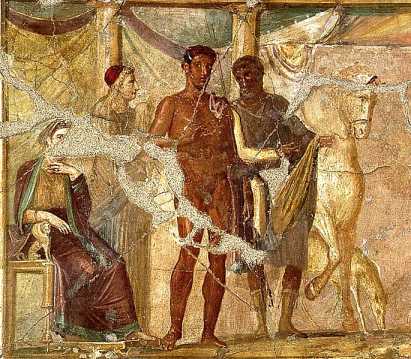
It should come as no surprise that the majority of the mythology surrounding Aphrodite revolves around her love affairs or the love affairs of those that she sparked. Aside from her pivotal participation in the Trojan War as portrayed by Homer, most of Aphrodite’s tales revolve around her being merciless and punishing others. Let’s go over the most important myths.
The Trojan War & The Judgement of Paris
Aphrodite plays a central role in causing the Trojan War. Since they didn’t invite her to Thetis, a sea nymph and Peleus’ wedding, the goddess of conflict, Eris, hatched a nasty plan. She presented Paris with a golden apple and instructed him to choose the most attractive deity among Athena, Hera, or Aphrodite.
While Athena and Hera bribed Paris with strength, power, and land, Aphrodite promised him something far more important: the most beautiful woman on the planet. Aphrodite chose Paris and promised him he could have Helen of Troy. However, because Helen was married to Sparta’s king, Menelaus, they needed to devise a strategy. Aphrodite blinded Helen, so she would agree to follow Paris to Troy. That made Menelaus and his brother, Agamemnon, start an excursion against Troy.
Not only that, but Aphrodite was a vast supporter of the Trojans since she had an affair with a Trojan man, Anchises, with whom she had a demi-God son, Aeneas. Aphrodite persuaded Ares to side with the Trojans and meddled multiple times, saving Paris from Menelaus and her son from Diomedes.
After the end of the Trojan War, Aphrodite assisted in saving Aeneas and helping him escape, as well as helping Helen by making Menelaos fall in love with her again, to avoid any idea of retribution.
Atalanta and the Golden apples
Atalanta, a renowned huntress in Greek mythology, was determined to remain unwed, setting a condition that any suitor must outrun her in a footrace to win her hand, knowing well that none could match her speed. However, Aphrodite, the goddess of love, intervened on behalf of Hippomenes, a suitor deeply in love with Atalanta. Aphrodite gifted him three irresistible golden apples from the gardens of Hesperides.
During the race, whenever Atalanta surged ahead, Hippomenes would drop one of these apples. Intrigued and distracted by the golden fruit, Atalanta would stop to pick them up, allowing Hippomenes to gain a lead and eventually win the race, and her hand in marriage, with the divine assistance of Aphrodite.
The Wrath of Aphrodite
Her curses and wrath have stuck multiple times, either due to jealousy or extensive privilege and self-absorption.
Her divine privilege has led her multiple times to punish mortals and gods. Every time someone did not worship her enough, she could punish them severely. For instance, she had punished:
- Hippolytus, by making his stepmother, Phaedra, fall in love with him, which led to his murder by his father, Theseus, The Founding Hero Of Athens.
- Menelaus, the Lacedemonian king, has promised to sacrifice a hundred sheep to Aphrodite if he won the hand of Helen, but he failed to do it. Thus, Aphrodite punished him by making Helen fall in love with Paris and leave him.
- Smyrna or Myrrha, a Cypriot princess who scorned the goddess and she filled her with desire for her father. Zeus saved her by turning he into a myrrh tree, from which Adonis was born.
and others, like Acmon, the brothers of Halia, Cerastai, Lemnian Women, Pasiphae, and Tyndareus.
Aphrodite could hold a grudge
All of the above were only punishments because they did not worship her divinity. She also unleashed her wrath on people who failed her personally. For instance:
- Diomedes wounded Aphrodite during the Trojan War, so she punished him by making his wife have an affair and drive him away from Argos with the help of her lover.
- Erymanthos, Apollo’s son, was turned into a boar when he saw Aphrodite with Adonis.
- Heracles lost his life because of Aphrodite after she made his wife, Deianeira, soak his robe in poisoned blood from centaur Nessos, which would kill Hercules if he ever cheated on her – which eventually happened. Aphrodite did this because Hercules had seduced Adonis.
- Narcissus, a self-absorbed beautiful young man who played with anyone who wanted his love. For that, Aphrodite made him fall in love with his own reflection.
and others, like Pan, Anaxarete, Calliope, Cleo, Glaucos, The King Of Corinth, Eos, Helios, Orpheus, the legendary musician, Polyphonte, and the Sirens.
The most famous wrath story is the one of Psyche. She was a goddess so beautiful, that people started worshipping her. Aphrodite sent Eros to punish her, but he fell in love with her. Psyche, The Deification Of The Human Soul betrayed him and asked Aphrodite’s help, but she sent them to do impossible labors. She was then reunited with Eros, and they are connected since then.
Aphrodite in Ancient Greek Religion
Being the goddess of love, Aphrodite was widely celebrated and worshipped in Greece – and we saw what happened to those who did not worship her!
Sites Sacred to Aphrodite
Temples dedicated to Aphrodite stand throughout Greece and Asia Minor. You can find temples on Cythera, Cyprus, Delos, Paphos (the oldest), and Skyros. Other islands also show traces of these temples.
Only the sanctuary inside the Agora and the temple in Daphne, as recorded by Pausanias, are located in the heart of Athens. Shrines can also be found in Corinth, Sparta, and other parts of the Peloponnese. The most prominent temple, however, was in Syria’s Ascalon.
Worship & Festivals
The main festival worshipping Aphrodite was the Aphrodisia, taking place in the middle of summer in Athens, Corinth, and other Greek cities. It was a celebration of love, where no blood sacrifice was permitted, other than the white dove. She was also worshipped during the Arrheforia. Every month, the fourth day was devoted to Aphrodite.
Try The Aphrodite Crossword
Find out how much you learned about Aphrodite by playing this game!
You can also play around with Aphrodite’s and other Olympian gods’ names in this fun anagram game:
Representations of Aphrodite in Art
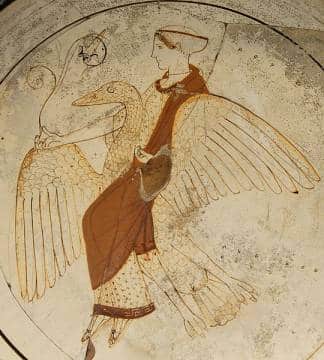
Throughout the centuries, Aphrodite has been the central focus of countless artistic renderings. In the Archaic period, she wore full clothing, often with her magical girdle or a mirror. Artists began depicting her naked from the 4th century BC onwards. The Louvre Museum houses one of the most renowned statues of Aphrodite, the Venus de Milo. Botticelli’s Birth of Venus stands as the most famous painting of her.
In The Old Texts
Aphrodite appears frequently in Greek and Roman literature. Homer has extensive descriptions of Aphrodite, especially her wrath. However, her role in Virgil’s Aeneid is far greater, as she is ever present to assist her son, Aeneas.
A great source of information is also the Homeric Hymn to Aphrodite. She also appears in many tragedies, like Euripides’ Hippolytus, where she is mostly referred to for her insistent wrath.
FAQs
Aphrodite was the goddess of love, sexual desire, pleasure, and fertility. She was the one setting the sparks of love in both mortals and deities.
Zeus and Dione, or just Uranus.
Aphrodite was married to Hephaestus, who she cheated on with Ares. Other sources present Ares as her husband.
Eros, the winged god of love, and Himeros, the god of desire.
Aphrodite is associated with Freyja.
Sources
Orphics
- Hymn to Aphrodite
Ovid
Pausanias
- Description of Greece 1.3.1
Pseudo-Apollodorus
- Bibliotheca 3.183
Virgil
- Aeneid 2.467
Featured Image Credit: Dave & Margie Hill / Kleerup from Centennial, CO, USA, CC BY-SA 2.0, via Wikimedia Commons

